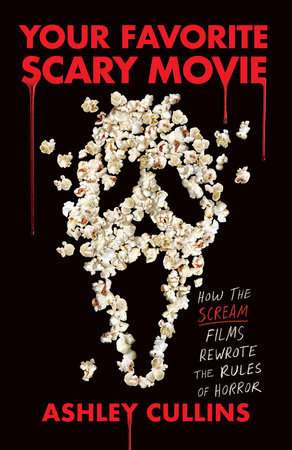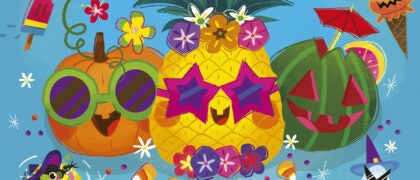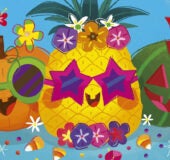Chapter One
Rewriting
Horror
Scream is a love letter to scary movies, written by a disenchanted admirer who knew that the genre wasn't living up to its potential. Seeing Halloween as a kid was a defining moment for Kevin Williamson. So, when he made it to Hollywood, he took horror into his own hands. Determined to re-create that feeling, Williamson poured his frustration and passion onto the page. The result was not just a great slasher but something truly iconic.
Scream not only changed his life and career but altered the trajectory of the horror genre. In retrospect, it's hard to imagine that anyone was surprised by its impact, but the movie that is now a global phenomenon and has sparked a billion-dollar franchise started as a low-budget project from a fledgling studio that was written by a novice and starred a mostly unknown cast-and no one who was involved, even the most optimistic among them, had any idea they were about to become part of the zeitgeist.
Least of all Williamson, who was a struggling screenwriter back in 1995. He'd already sold a script, sure, but it was languishing in development hell, and he was broke.
"I had sold Killing Mrs. Tingle to Interscope with Joe Dante attached to direct," recalls Williamson, who took a job as a personal assistant to a director to make ends meet. "It was a very, very little option. I think it was $75,000, which sounds like a lot of money, but I was about $100,000 in debt. It was so sad because I thought I had made it-and, no, I had not made it. I was in West Hollywood in a rent-controlled apartment for $650 a month and it got hard to pay that bill, believe it or not."
Determined to make it as a writer, Williamson went back to the drawing board.
"I was trying to come up with another movie to write because Tingle wasn't getting made," he says. "No one was making good horror movies. So, I wrote the movie I wanted to see."
That movie was Scream, an unexpected and updated take on a slasher flick that simultaneously celebrated and satirized the films that came before it.
How Williamson wrote the genre-bending film has become lore over the decades.
As the story goes, he holed up in a condo in Palm Springs and hammered out the screenplay in just three days. "That's sort of an urban legend at this point but, yeah, it's true," Williamson says before clarifying, "I wrote an outline first, though."
The genesis of the story dates back even further.
A lifelong horror fan, Williamson had become hooked on storytelling as a kid thanks to his mother's Doubleday Book Club copy of Peter Benchley's Jaws-which was confiscated by a teacher in elementary school who thought it wasn't age appropriate. He stood in line for four hours at a small-town Texas movie theater when Steven Spielberg's movie adaptation first came out but it was a full house, and he was turned away. The next day he went back and waited even longer. "I got in, and I was in the front row," Williamson says. "I just loved the adrenaline and the way everyone reacted to that film."
After Jaws sparked Williamson's interest in movies, seeing John Carpenter's Halloween set it ablaze. "The way everyone kept screaming at the screen, the way everyone was saying, 'Don't drop the knife, don't drop the knife,' all of those things that make that film so memorable, I loved it. I went back and saw it again and again and again," Williamson says. "I knew I wanted to do that with my life. I wanted to make people feel that way."
Williamson pursued that passion at East Carolina University, where he studied theater. "In college, I had written this comedy, a one-act play, about a young girl babysitting," Williamson recalls. "She gets this creepy call and they start discussing all the tropes of horror films. It was this forty-page mess of ideas, and I never even mounted it in college. A few people read it, and then I put it away as if I'd never written it. I totally forgot about it."
Years later, while he was living in L.A. doing odd jobs and trying to break into Hollywood, a true-crime story caught his attention. He was home alone, house-sitting for a friend in Westwood and watching a prime-time news special about Danny Rolling, a Florida serial killer dubbed the Gainesville Ripper. "It was the most gruesome story I had ever heard. It was so horrific the way that he would break into their back doors with a screwdriver," Williamson remembers. "These unsuspecting people, he would just sit outside and listen to them on the phone. Then, when they'd get off the phone, he'd wait for them to go to sleep. It was terrifying."
It's not exactly the kind of story you want to discover while alone in a strange house-especially when you've got the imagination of a prolific screenwriter. "I remember getting so scared that night," Williamson says. "And I walked into the family room and the window was open. I was like, 'Wait, that window was closed. What is it doing open?' I was trying to call the homeowner and say, 'Did you leave your window open? Has it been open for three days and I've never noticed?'"
When he couldn't get ahold of him, he dialed his friend David before investigating further. "I was like, 'Okay, there is a window open in the house. I think someone's in the house.' He goes, 'Well, get out of the house!' I grabbed a knife and I started walking around, checking under the bed and behind the shower curtain, and he was on the phone with me to keep me company," Williamson says. "He was being a jerk and going, 'Kill kill kill kill.' He goes, 'Yeah, Michael Myers.' I'm like, 'No, that's Jason Voorhees.' And we got into this whole discussion about horror films."
Once Williamson was satisfied there was no intruder and relief set in, a lightbulb went off: "I thought, 'I'll deconstruct the horror film the way that Stephen Sondheim deconstructed [the stories in] Into the Woods.' That was my favorite musical. I saw it a hundred times when I was waiting tables in New York next door to the Martin Beck Theatre. I kind of used that as my inspiration. I sat down and I was like, 'Where do I start?'"
He never did find the one-act play he'd written in college, but he hadn't forgotten it either. The phone call from a stranger that he'd conceived years earlier melded with the ruthless real-life ripper that was fresh in his mind. "That's how it all came together, and then I started writing the opening scene," he says.
When it dawned on him that he needed enough story for an entire movie, he switched gears. "I realized: Forget the opening scene. This story is about someone else," Williamson says. "I created the character of Sidney Prescott and this whole big story about the death of her mother and how she's traumatized by that and how it has affected her relationships and who she is and how she navigates high school life."
This is where that fabled trip to Palm Springs comes in. Williamson's friend, the same one he was house-sitting for when Barbara Walters scared the bejesus out of him, found a condo he could have for the weekend. "I thought, 'I'm gonna go away and I'm gonna write this movie and get it out of my system,'" he says. "I wrote an outline and I took it to Palm Springs. I locked myself in a condo with no TV and for three days I wrote Scream. I came back with a draft. It was pretty close to what I sold."
At the time his screenplay was called Scary Movie-a cheeky nod to the genre he didn't realize he was about to upend. It's the story of Sidney Prescott, a teenager struggling to overcome the grief of her mother's murder as a mysterious ghost-faced killer begins terrorizing high schoolers in her small town. Unlike generations of unlucky teens before them, these kids have seen scary movies and they know the rules of slashers.
"Every horror movie has its thing. For Scream, I thought it could be a mystery where we have a different killer every time and that would be the gimmick," Williamson says. "I was a big Agatha Christie reader as a kid and I really enjoyed the reveals. I read that she works backwards and so I constructed Scream backwards. Once I latched on to two killers, I stopped everything and restructured it so that it all made sense. I already had it all planned out, but when I started taking those two characters and working them backwards, it all fell into place."
Halloween, which is still Williamson's favorite movie, was also an inspiration.
"That's the perfect coming-of-age story," he says. "You have this one character who is a straight-A student, she's a good girl, she's babysitting, she's taking care of kids, she's gonna die to protect them. She does everything right and still horror comes and knocks on her door, still violence and terror come and hunt her down. How is she going to respond to this ultimate act of life and death, and can she survive the night? I would watch that and go, 'How can I do that with Sidney Prescott? How can I turn her into the new Laurie Strode?'"
Williamson tapped into two themes that have become common in his work: betrayal and family. "I've always felt like betrayal is a big thing in my life. I write about it a lot, and lies and deceit. I always felt like Sidney had such a distrust of people around her and she is also dealing with grief. I latched on to her mother being dead and her father being absent as a result of that," he explains. "Her mother was murdered and she put the guy away, but it was the wrong guy and now she doesn't trust herself. It's all about trust. Her whole relationship with herself or with Billy was about that trust and belief in the lies. Can she trust this man she loves? Then she chooses to trust him and he, of course, is the killer."
While he was commenting on the genre, Williamson also made it a point to spotlight the current culture, something that would become a hallmark as the franchise continued. Scary Movie was both a love letter to and an indictment of slashers-and it was a message to people who blamed entertainment for society's problems.
"Bob Dole was going off on all the violence in cinema at the time. He was really going after Quentin Tarantino and Natural Born Killers," Williamson remembers.
Then U.S. Senate majority leader, Dole made criticism of Hollywood a repeated theme during his failed run for president. During a May 1995 campaign stop in L.A. he lamented that "Hollywood's dream factories turn out nightmares of depravity" and criticized the "mainstreaming of deviancy" in music and movies. He couched the comments by saying the country's problems weren't entirely Hollywood's fault, but in very same breath added, "But a numbing exposure to graphic violence and immorality does steal away innocence, smothering our instinct for outrage, and I think we have reached the point where our popular culture threatens to undermine our character as a nation."
Williamson channeled his frustration with the sentiment into his art. The cornerstone of Scary Movie was the line "Movies don't create psychos, movies make psychos more creative," which he had written on a notecard and taped to the wall. "If you look at all the reports, there's no real relationship. I watched all those violent movies growing up and I'm scared of blood. Real blood, real violence freaks me out," Williamson says. "I believe, like Quentin believes, that the movies are where you can take the darkness. Fiction is the only place you can take this darkness and live in it because you can close the book, and you can turn the TV off, and you can leave the theater. You can play in that darkness and then you step out of it and come back to the real world and you're in the light."
Ultimately, Williamson's movie was a new take on the slasher flick, one that was self-aware and infused with humor-the kind that would make an audience laugh with the characters instead of at them. It not only subverted clichés but openly defied them.
"When I had it in my hands, I was so happy," Williamson recalls. "I thought it was good, but I thought Tingle was good."
He sent it to a friend's manager in the Valley and the initial feedback wasn't exactly encouraging. "He read it and went, 'It's not a real horror film. Is it a comedy? Is it a horror film? What is it? I think you need to decide. This is not working,'" says Williamson. "I was devastated, and I didn't know what to do."
Williamson figured if no one bought Scary Movie maybe he could make it on his own-like Robert Rodriguez had done with El Mariachi just a few years earlier. The director had detailed how he pulled it off-including raising half of his $7,000 budget by participating in clinical drug tests-in both DVD special features and a book. "I had read Rebel Without a Crew and I thought, 'Well, maybe I can get a credit card and max it out and make my own movie,'" Williamson says. "That's why the locations were minimal. I had been working in music videos, so I knew how to put little crews together. I knew how to do something for nothing. So, I thought maybe I could just make it myself."
Copyright © 2025 by Ashley Cullins. All rights reserved. No part of this excerpt may be reproduced or reprinted without permission in writing from the publisher.









